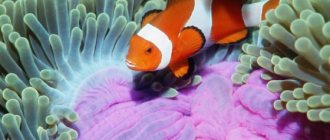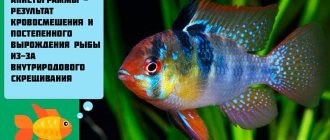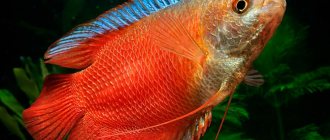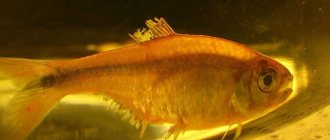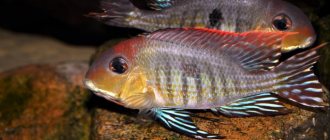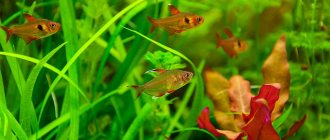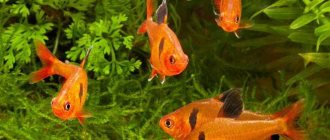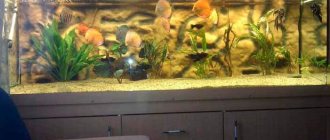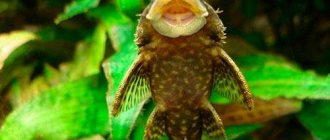This is one of the oldest representatives of the underwater world on our planet. It has several names - pantodon, butterfly fish, and some aquarists call it moth fish. In the wild, Pantodon Buchholzi live in stagnant freshwater bodies of water or shallow, calmly flowing tropical rivers. This is a predator whose impeccable hunting tactics have been perfected over thousands of years.
For breeding in an aquarium, fish are quite whimsical and require special conditions.
Appearance
Apistogramma Ramirezi is one of the most common, small-sized cichlids. The chromis butterfly attracts the attention of aquarists, first of all, with its bright color and non-standard appearance. The dimensions of this aquarium fish are 5-7 cm, which makes it possible to keep it even in small aquariums. For the first time, people learned about the chromis butterfly in 1948. In one of the US aquarium magazines, a fish from South America appeared under the name Apistogramma ramirezi
. Why Ramirezi? Everything is simple here, it was named after Manuel Ramirez, a well-known importer of aquarium fish at that time. Since then, a large number of artificially derived apistograms have appeared. Such species appeared as Apistogramma ramirezi veil, golden (gold), albino, blue, balloon (with a round body shape). But the brightest of all the bred species is Apistogramma electric blue neon. In addition, of all the breeding species, electric blue neon is also the strongest in terms of health, which is not the case with, for example, gold and albino. Apistogrammas with a balloon body shape, even under good conditions, can die due to congenital deformation of the internal organs. In my opinion, aquarists should not purchase cylinders. But the rest of the variety of species deserves, at a minimum, the attention of aquarists. After all, the butterfly cichlid is one of the brightest aquarium fish with interesting behavior!
Types of apistograms:
Ramirezi apistogram
Apistogramma Ramirezi electric blue
Apistogramma gold-gold
Apistogramma ramirezi balloon
Habitat in nature
The African butterflyfish (Pantodon buchholzi) was first discovered by Peters in 1876. It lives in western Africa - Nigeria, Cameroon, Zaire.
The name of the genus - Pantodon (Pantodon) comes from the Greek - pan (all), odon (teeth) which can literally be translated as all-tooth. And the word buchholzi reproduces the surname of the professor who described it - RW Buchholz.
Habitat: dark waters of western Africa, in lakes Chad, Congo, Niger, Zambezi. Prefers places without current, but with a large number of plants floating on the surface.
In nature, they hunt near the surface of the water, feeding mainly on insects, larvae, nymphs, but also small fish.
This fish can be called a fossil species, as scientists believe that it lived unchanged for more than 100 million years!
She did not adapt to changes in her environment and is still alive. Her entire body is adapted to jumping out of the water, her eyes are positioned to see everything above the water, and her skin has special receptors that sense micro-vibrations in the surface of the water when an insect falls on it.
This is an ideal insect hunter, the effectiveness of which has been tested over a huge amount of time.
Maintenance and care in the aquarium
The butterfly chromis is the most common small cichlid in the freshwater aquarium. These fish live about 4 years. Which is quite a lot for small fish. Compared to other cichlids, the Ramiresi Apistogram is quite calm and non-aggressive, but moderately territorial. Ramirezi recommends about 30 liters of water for steaming. You should not have two pairs with a volume of up to 50 liters, as the males will begin to fight for territory and females. Despite the fact that butterfly cichlids can scare away fish from their territory, they will not cause serious harm even to such peaceful fish as swordtails or heteromorph rasbora. But still, apistograms can only offend shrimp.
Comfortable temperature for these beautiful fish is 24-28 °C. Water pH: 6.0-7.5, hardness 6 - 14°.
Description
It is called the butterfly fish because, when viewed from above, its widely spaced fins resemble the wings of a butterfly.
They are silvery brown with dark spots. With the help of these beautiful and large fins, the fish can jump out of the water to catch insects that fly above the surface.
In nature they grow up to 13 cm, but in an aquarium they are usually smaller, about 10 cm. Life expectancy is about 5 years.
Wide pectoral fins are adapted for sharp throws over short distances. The large mouth is designed to feed from the surface of the water and grab insects.
Normal behavior is to ambush and wait at the surface of the water. She also has a swim bladder that not only serves to maintain body balance, but also to breathe air, which is a unique feature.
Content problems
The Apistogramma Butterfly is not the most difficult fish to keep, but in order to avoid problems and difficulties in keeping, you need to follow several rules:
- A varied diet in small portions 2 times a day
- Stable water indicators. The fish is very sensitive to changes in various parameters: temperature, hardness, acidity.
- It is advisable to change water once or twice a week in small volumes. Since the fish lives near the bottom, soil siphoning must be carried out regularly.
- In an aquarium, shelters in the form of grottoes or plants are required.
- It is advisable to regularly test for ammonia and nitrates when changing water.
The most common problem is that the ramirez apistogramma has darkened and is not eating.
This happens either due to stress, for example, just adding a fish to the aquarium, or due to improper maintenance of this wonderful fish.
If you follow the rules stated above, you will not have any difficulties with apistograms.
Bolivian butterflies: habitat
Bolivian butterfly fish have small body sizes (6-8 cm) and a flattened body shape. There are several color options, including an albino form. The habitat of this type of fish, as the name suggests, is the river of Bolivia, Brazil. Cichlids prefer slow or still waters with plenty of vegetation. Individuals successfully adapt to life in an aquarium; the main thing is to achieve the necessary conditions for keeping butterflies. Since they are predatory fish, they will eat fry, shrimp and other small fish.
We recommend reading
Ancistrus catfish: maintenance, care and breeding
The Bolivian butterflyfish, known as chromis, should not be confused with the ramirez apistogramma, since the latter, although a related species, has a much smaller body size and is distinguished by a bluish coloration (also called the dwarf butterflyfish).
Feeding
Apistogramma ramirezi is a fish that likes to eat a variety of foods. You can feed them both live food, having previously washed and disinfected it, and frozen food. For variety, you can also give small quantities of plant-based dry food. Chromis butterfly is a modest fish that likes to eat in small portions, so make sure that the fish has time to eat after the rest of its swallowing neighbors. This type of nutrition also applies to breeding forms of apistograms, such as electric blue neon, albino or gold.
Who do “butterflies” get along with?
As already noted, finding neighbors for pantodons is not so easy, but the point is not only in their disposition, but also in not entirely standard living conditions. It would also be useful for the owner to learn about the following features of these creatures:
- In fact, butterflies get along well with other fish, except small ones, which they can only value as food.
- They live in the upper layer of water and can compete for this territory with other inhabitants.
- Those who live on the “floors” below, for example, in the middle strata and at the bottom, are not at all interested in them.
- Also, you should not place rowdy fish in the pantodons, which “sin” by tearing off the luxurious fins of their neighbors, for example, Sumatran barbs do this.
How to distinguish a female from a male?
Apistogramma ramirezi has very pronounced gender differences. Males are larger, brighter, and have a long, pointed fin. The female from the male in Ramirezi's apistogram can be distinguished by its brighter abdomen; it is either orange or scarlet. The male is larger and has a more pointed dorsal fin. The female Apistogramma butterfly, in turn, is smaller and slightly paler, with a short dorsal fin and a crimson belly.
Ramiresi apistogram. Male and female
Butterflyfish, butterflyfish or pantadon (Pantodon buchholzi). Photos and videos of butterfly fish
Butterfly fish, butterfly fish or pantadon (Pantodon buchholzi) are the names of the same freshwater fish that lives in the tropics. This fish belongs to the Aravanidae family (Osteoglossidae), although more recently they were separated into a separate moth family (Pantodontidae). The freshwater butterflyfish is closely related to the Aravanidae and has no relation to the marine coral butterflyfish.
Butterfly fish lives in fresh, stagnant bodies of water with slightly acidified water. The homeland of this fish is the reservoirs of Western and Central Africa: the Zambezi River, Niger and Congo, Gabon, Uema, Benin, Jong Lake Chad. Inhabits creeks, streams, swamps, river basins, which are densely overgrown with plants, with a water temperature of +23 - +30°C. Sometimes it can be found in small lakes, which are hidden in the thicket of the forest.
The butterfly fish has a unique body shape and coloration. Its dimensions are small - up to 12 cm in length. The body is compressed on the sides, the head and back are slightly flattened from above. The pectoral fin is wide and large, similar to wings. There are four pelvic fins, they have long filamentous rays that are located under the pectoral fin.
The dorsal fin is short and located just in front of the tail. The dorsal fin has 6 soft rays, the anal fin has 9-15 rays, in males the rays from the middle of this fin, during the spawning period, form a copulatory organ in the form of a tube. The tail is long and pointed at the end, with two elongated rays.
The coloring of females and males is the same, although males look brighter. The upper part of the fish’s body is brown-green in color with alternating regular stripes and spots, while the lower part is yellow and has dark spots. The fins are brown-pink. The scales shimmer with a silver-golden color, are cycloid, large, and round in shape.
Most often, butterfly fish swim near the surface of the water, spreading their pectoral fins to the sides, which touch the surface, and lowering their abdominal fins down. It hides under the large leaves of aquatic plants. It is a nocturnal predator and can pick up fallen insects on the surface of the water or catch them.
It catches its prey in flight: it jumps out of the water and, with the help of large pectoral fins, soars across the surface of the water. This flight is reminiscent of the flight of a butterfly, which is why the fish got its name. The fish's body is well adapted to such flights: a vascularized swim bladder, which allows it to breathe oxygen from the air at the surface of the water; nostrils that protrude in the form of small tubes and wing fins.
The upper mouth has a large number of teeth and is well adapted for capturing prey from the surface of the water. The position of the eyes on the body allows them to constantly inspect the water surface. The fish can use its flight-jump in case of danger, escaping from predators. It can fly over the surface of the water at a distance of 2-3m. In addition to insects, this fish can also feed on small fish and crustaceans.
Butterfly fish exhibit sexual dimorphism. Males are brighter in color and smaller, and also have a deep cut in the anal fin, which can be used to distinguish a female from a male.
Fish breed in the spring. Spawning games usually occur in the evening or at night (in the dark) and last for quite a long time. The male swims slowly, circling the female in spirals in front of her, periodically copulating with her. The number of copulations is 5-10.
Sperm, introduced once by a male, most likely retain their vital activity for a long time, since subsequent laying of eggs sometimes occurs without secondary fertilization. Transformation with metamorphosis. As a result, this fish goes through the following stages: eggs, larva, fry, adult.
The eggs are large, dark brown in color, and contain fat droplets, thanks to which they float to the surface. The eggs hatch into larvae 48-64 hours after fertilization, after which they sink to the bottom. After the yolk sac disappears from the larva, it, already a fry, rises to the surface of the water. The fry are predators from birth and feed on very small live food.
Thanks to such a bright appearance and relatively simple living conditions, this fish came to Europe. This type of fish was brought from Africa to Europe in 1905. This fish attracted people with its unusual appearance and many wanted to keep it at home. For a long time, it was not possible to breed it in captivity, and only in 1912 did the Berlin aquarist Lehmann manage to get offspring. And now this type of fish has not lost its popularity among aquarists.
The conditions for keeping it in the aquarium are as follows. The butterfly fish feels comfortable and safe in a large shaded aquarium among floating plants with huge leaves that spread on the surface of the water. It is recommended to keep these fish in low, wide aquariums.
If you keep one fish, then an aquarium with a volume of 40 liters or more is suitable, but if there are several fish, then 70 liters, provided there are no other aquarium fish. The top of the aquarium should be covered with glass, and there should be a distance of 10 cm between the surface of the water and the glass. The water temperature should be 24-26°C, soft water with a pH of 6.5-7.0.
They take food from the surface of the water; they prefer various small insects - crickets, cockroaches, flies, as well as insect larvae and small fish. Before feeding, microdoses of vitamins and hormones are often added to such food. If such food is not available, it can be replaced with pieces of raw meat, shrimp, and shellfish.
You can also teach them to eat special dry concentrated food, but the fish may develop vitamin deficiency. Its signs are the fish lowering into the middle layers of water or to the bottom of the aquarium (if this is not fear or sleep).
Quite aggressive behavior towards fish that live in the upper layers of the water of the aquarium; if a neighboring fish fits into their mouth, they can eat it. Neighboring fish that occupy the middle layers and the bottom of the aquarium are treated neutrally. At the same time, butterfly fish themselves can suffer from other predators in the aquarium; their fins, with long rays lowered into the water, can be bitten.
They should be kept with large, non-aggressive upper and mid-level fish and bottom-dwelling aquarium fish. The vegetation of the aquarium is dense, but there should be empty areas of it. Breeding butterfly fish is quite problematic, since it requires constant care for itself and its offspring, but it is possible.
To do this, you need to lower the water level in the aquarium by a few centimeters (for 1-2 weeks), add soft acidified water to shift the pH to a more acidic side and increase the water temperature to 26-30 ° C. With the help of such manipulations you can induce spawning in fish under artificial conditions.
Spawning, just like in the natural environment, is accompanied by violent mating games that last about a week. After several copulations, the female is usually placed in a separate aquarium with a capacity of about 50 liters. Fertilization is internal. As the female matures, she spawns from 80 to 220 already fertilized brownish eggs with a diameter of about 1.5 mm.
After the eggs rise to the surface, they need to be collected so as not to be eaten by fish, using a spoon and moved to the incubator. The incubation period lasts 48-64 hours, after which the larvae emerge from the shell, breaking it, and sink to the bottom.
There are cases when mature larvae cannot get out of their shell, in this case it is recommended to collect the eggs and throw them into the aquarium from a small height; hitting the surface of the water will help the larvae to free themselves. If this procedure is not carried out, the offspring will die by suffocation.
After complete resorption of the gall sac, the fry rise to the surface of the water and begin to eat. At first, they do not actively catch or search for food; they feed on small live food that floats up to the mouth.
At the beginning, it is recommended to feed the fry with small food cyclops, daphnia, which float on the surface of the water, and later mosquito larvae and fruit flies of fruit flies can be added to the diet. Juveniles become sexually mature between 12 and 16 months.
If you create optimal conditions close to their natural habitat, the butterfly fish can live up to 6 years and reach a length of up to 15 cm. The lifespan and body size of fish raised in aquariums may be higher than those of fish from the natural environment.
More interesting articles on the topic:
Clown botia: maintenance, compatibility, diseases, fish reproduction
The clown fish (Botia macracantha) is believed to have appeared in the mid-19th century. About this
The fish imitates the tentacles of a copycat octopus
“We have never seen anything like this before,” says the scientist. Small
Coelacanth - living fossil fish or coelacanth
Now on Earth there are practically no living organisms that are like lobe-finned fish
Blobfish, Australian goby, toadfish (Blobfish - Psychrolutes marcidus). Photos and videos of drop fish
Blobfish, Australian goby, toadfish (Blobfish - Psychrolutes marcidus) &nd
Hammerhead fish or hammerhead shark (Sphyrna zygaena). Photos and videos of hammerhead fish
The common hammerhead shark belongs to the family of hammerhead sharks of the order Carcharine.
The fish that hid from everyone in the aquarium for 15 years!
Employees of the Blue Planet Aquarium in Cheshire (one of the ten counties of New York
Breeding
In order to get a good pair of Ramirezi Apistogramma, you need to buy 5-8 juveniles. When they grow up, they find a suitable mate. Microgeophagus Ramirezi usually lays eggs on a flat stone, wide leaf or glass. As a rule, this happens in the evening. To stimulate spawning, raise the temperature by 2 degrees within 26-28 degrees and do a water change. To prevent them from eating eggs, you need to create a secluded place where their spawning will not be disturbed by other fish. The female lays about 200 eggs after the surface is cleaned. The male fertilizes the eggs and then guards them.
After spawning, the spawners are usually removed from the aquarium or the surface with eggs is taken into a small aquarium with the same water parameters.
2-3 days after spawning a larva will appear, and after another 2-3 days the larva will become a fry. If the larvae remain in the common aquarium, then the parents will watch them until the last: transfer them to safe places, clean them in their mouths and spit them out. This is a real spectacle! It is necessary to feed the fry only after their yolk sac has resolved. The fry of Apistogramma ramirezi is quite small, so it is fed with ciliates or rotifers, and it is recommended to feed the Artemia nauplius 4-7 days after the start of feeding. The main task will be to maintain clean water, constant feeding of the fry 5-6 times a day and stable water parameters.
Possible difficulties of keeping butterfly fish
It’s not worth starting your aquarium business with these unique fish, they are too whimsical and require special care:
- pantodons do not tolerate changing conditions very well,
- it is important to maintain constant water parameters,
- a body of water with a current is not suitable for them, so it is better to abandon the filtration systems that provide them,
- butterflies are demanding in nutrition, and most universal foods for aquarium inhabitants are not suitable for them,
- they feed on live food or insects,
- If you scare the fish, they will easily jump out of the pond, so the aquarium needs a lid.
Care
Mandatory butterfly care includes:
Combine soil cleansing with weekly water changes. Test your ammonia levels with water tests once a week.
Feeding
Butterflies tend to overeat, so feed the fish as much food as they eat in 5 minutes. After feeding, remove uneaten food particles. The omnivorous nature of fish allows them to have a varied diet.
Suitable frozen and live foods:
Diversify your diet with plant foods:
Use dry food as a supplement to your diet.
Compatibility with other fish
Peaceful apistograms live comfortably with any fish that do not show signs of aggression or increased possessiveness. Therefore, the choice can be made either based on a beautiful combination of colors, or on similar eating preferences.
When moving in with predators, the pets themselves will become food for larger creatures.
Different neighbors are suitable for different types of apistograms. For example, for balloons and altispinosas, guppies and cockerels are selected as cohabitants, and ramirezis are placed in the same aquarium with catfish or zebrafish . The cherry barb is always considered a good companion.
Butterflies in mythology
Interesting facts about butterflies, their origin and people’s attitude towards these insects can be learned by getting acquainted with archaeological artifacts. Butterflies are the most ancient insects. Excavations have uncovered remains that are 150 million years old. There are about 160,000 species of these unusual representatives of the fauna.
We invite you to familiarize yourself with: Rhodesian Ridgeback - African Lion Hound
In ancient times, butterflies, like everything mysterious and unsolved, were simultaneously admired and feared. The unusual nature of the insect provoked the mystification and deification of such a creature.
During excavations, frescoes of ancient Egyptians were found depicting butterflies. In those days, people identified human life with this insect.
For some peoples, a butterfly is a harbinger of happiness, joy, and love. Others believe that the fluttering insect is the souls of dead people, the embodiment of demons and witches.
In ancient Greek myths, butterflies are found in the role of Psyche - a girl who personifies the human soul, and the Scandinavian peoples came up with elves - kind people with butterfly wings. In India, the butterfly was considered the progenitor of the whole world. And Buddha dedicated an entire sermon to this insect. In many beliefs, the butterfly represents rebirth and immortality.
Such interesting facts from the life of butterflies will interest not only children, but also adults.
Compatibility and gender differences
The predator is non-aggressive and gets along with fish of the same size. You cannot add small fish to the aquarium; the pantodon will mistake them for food and swallow them. It is recommended to choose bottom-dwelling fish as a neighbor. The best butterfly neighbors:
- catfish;
- acanthophthalmus;
- angelfish;
- neon.
There are several types of fish that the butterfly fish will get along with in the same aquarium.
Male “butterflies” are smaller in size than females. The main difference is the anal fin; in the male it has a notch, in the female it has smooth edges. The female is larger and slower than the male
